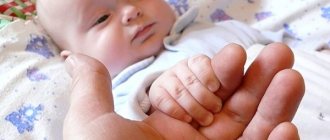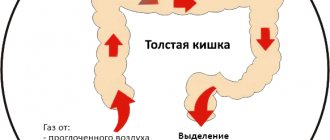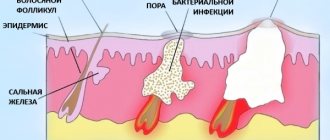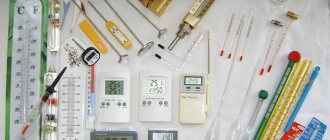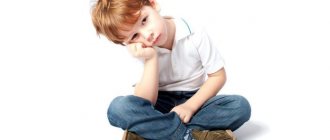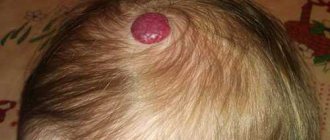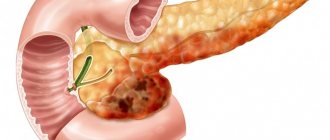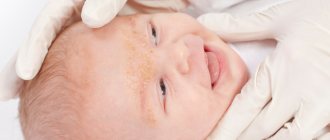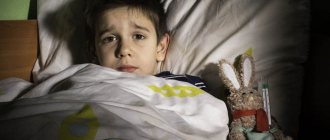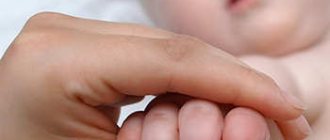Prerequisites for the appearance
The main factor contributing to the appearance of pain is the structure of the child’s ear canal. The Eustachian tube, which connects the ear to the nasopharynx in children, is shorter and wider than in adults. Through it, bacteria easily penetrate from the inflamed nasopharynx or from the outside into the inner ear cavity.
The absence of fever during ear pain should not reassure parents. Otitis externa in young children often occurs without visible complications. Pain can also become a symptom of serious diseases: lymphadenitis, rupture of the eardrum. Therefore, ear pain cannot be ignored.
Dr. Komarovsky about ear pain
Evgeny Komarovsky considers otitis media to be the most common cause of severe ear pain. Moreover, one of the three parts of the ear can become inflamed - the outer, middle or inner.
A video episode of Dr. Komarovsky’s program on the topic of childhood otitis can be viewed below.
If the outer ear is inflamed, it is clearly visible to the naked eye, there is no acute pain, and helping the child is quite simple. Otitis media, as the name suggests, is an inflammation of the middle ear, the area on the other side of the eardrum. This disease causes severe pain. This is the diagnosis that doctors make in most cases for children who suddenly begin to experience pain and shooting in the ear.
Otitis of the inner ear, or as doctors also call it “labyrinthitis,” is the most serious of the variations of ear inflammation . Fortunately, such otitis media does not occur often. Komarovsky argues that internal inflammation quite rarely occurs as an independent disease; usually this condition is a consequence of untreated otitis media or its complications due to improper treatment or complete absence thereof. Labyrinthitis can also be a consequence of a severe infectious disease.
In the middle ear, which becomes inflamed in most cases and causes a lot of unpleasant sensations for children of all ages, there is a special space, the so-called tympanic cavity, in which the auditory ossicles are located. Without any problems, it can receive sound vibrations and transmit them further - to the internal compartment, the middle one can only when the pressure in this cavity is at the same level as atmospheric.
This level is “monitored” by the Eustachian tube, which performs a special mission. It connects the cavity to the pharynx. When a child swallows, this tube opens and allows air to enter, the pressure is maintained at normal levels, and the ear is ventilated.
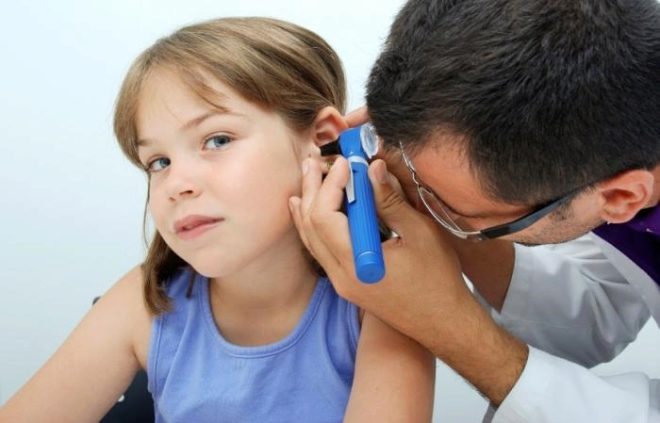
When the pressure changes, otitis media occurs. An imbalance within the tympanic cavity occurs when a child dives into water, but this is not the most common cause. More often, the patency of the connecting Eustachian tube is disrupted, and the pressure can no longer be maintained at the same level as atmospheric pressure. This happens during inflammatory processes in the nasopharynx, for example, with a cold or viral infection.
Children often sniffle because they cry more often, and also with a runny nose, if some of the mucus from the nose penetrates into the nasopharynx, and from there into the Eustachian tube. And this also causes the development of otitis media.
As soon as the pressure in the cavity changes in a negative direction, the cells that form the basis of the cavity begin to produce a specific fluid. The child develops severe pain. In most cases, hearing is reversibly affected. If urgent measures are not taken, after two or three days the inflammation becomes purulent; sometimes, under pressure, the eardrum cannot withstand it and ruptures, and pus begins to leak out.
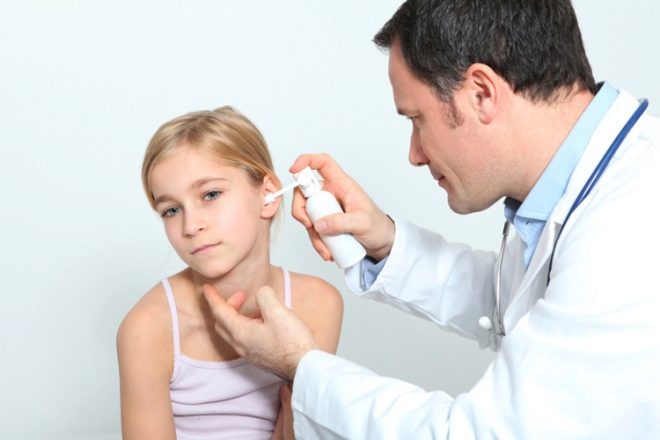
It is much more difficult, according to Komarovsky, to determine otitis media in an infant. Unreasonable crying, restless behavior, and sleep disturbances can arouse suspicion among parents. But you can confirm your guess with a simple manipulation.
You need to lightly press on the tragus (small protrusion in front of the auricle). If the baby is suffering from otitis media, then such pressure will greatly intensify the pain and the baby will burst into a heart-rending roar. If, when pressed, the child does not change his behavior, you need to look for the cause of his anxiety not in his ears, but in something else.
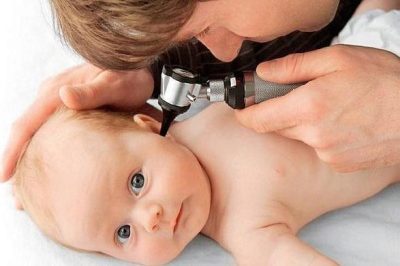
If pain in a child’s ear is accompanied by a symptom such as the appearance of a lump behind the ear, which hurts when pressed, a more thorough examination and additional diagnostics will be needed, as this may be a sign of mumps, rubella and other acute infectious diseases.
How to recognize
It is not always possible for a child to report pain independently. Actively speaking children themselves talk about their illness. Kids can show where it hurts. Diagnosing ear pain in infants and newborns is particularly difficult.
There are a number of signs by which you can determine whether a baby has ear pain: • Pressure on the ear protrusion (tragus). When lightly pressed, the baby begins to cry out sharply; • With prolonged pain, the child tries to scratch his ear on the pillow, showing the place where it hurts; • If you warm the inflamed area with your palm, the baby will calm down. Symptoms characteristic of any age: • Hearing impairment; • Decreased appetite; • General poor health; • Restless sleep.
Causes
Inflammation can be triggered by hypothermia, inflammatory processes in the nasopharynx, water getting into the ear while swimming, insect penetration, or stuck small objects. Teething and the appearance of wax plugs also contribute to pain.
Infants are susceptible to ear inflammation due to incorrect posture during feeding. If a mother feeds her baby while lying down, mucus from the baby's nose flows into the ear, causing inflammation.
Depending on the cause, the symptoms of the inflammatory process may vary. 1. Pain due to teething. In this case, the ear and nose hurt. 2. Water getting inside the ear cavity. Stagnation of water provokes inflammation, which causes discomfort and contributes to the onset of otitis media. 3. Sulfur plug. In this case, the pain is bursting, there is a significant decrease in hearing, and tinnitus. Pain in and around the ear. 4. Allergies. A runny nose provokes swelling of the nasopharynx and ear canal. Pain may occur as a consequence of allergic rhinitis. 5. Lymphadenitis (inflammation of the lymph nodes). The baby has an increase in nodes behind the ears and on the neck. With lymphadenitis, the area around the sink, the throat when swallowing, and the neck when turning the head hurt. 6. Traumatic injury. The cause may be an ear bruise or loud, sharp sounds. The child complains of congestion, possible bleeding, and pain inside the ear. 7. Foreign bodies: small objects, toys, insects. Once inside, they provoke swelling of the skin, cause pain, itching, and hearing loss. 8. Increased intracranial or blood pressure. There are unpleasant sensations in the back of the head and temples. The baby has a headache and hearing loss.
If you suspect ear pain, your child should be seen by a doctor. He will give specific recommendations applicable to different cases.
The child has an inflamed lymph node behind the ear
Causes of enlargement and inflammation of the lymph nodes behind the ear
However, it is necessary to clearly distinguish between the concepts of “enlargement” and “inflammation” of the lymph node (lymph nodes) behind the ear in a child.
And although the increased size may persist for another month after the underlying disease has been cured, this in itself is not a sign of a dangerous inflammatory process.
Inflammation differs from simple enlargement of the node:
- soreness (both constant and when touched),
- redness (blue discoloration) of the skin over the “bump”,
- an increase in temperature in the affected area,
- rapid swelling of the node during the day.
The change in skin temperature over the “bump” changes with bacterial infections and, as a rule, does not change with viral ones.
Adenoviral infection is manifested by nasal congestion, conjunctivitis, and sore throat. Rubella and measles are accompanied by a characteristic skin rash. With infectious mononucleosis, the spleen and liver become enlarged, and all lymph groups swell. In case of careless contact with pets (especially cats), cat scratch disease can develop, in which the group of lymph nodes serving the scratched area becomes inflamed due to infection with bacteria. In this case, patients take a course of antibiotics for 10-14 days. With viral diseases in the neck and head, a multiple increase in small subcutaneous “buckshot” nodes can be observed.
Diseases related to potential causes of changes in the condition of the lymph node can be divided into:
- immune (rheumatism, lupus erythematosus, etc.),
- infectious (for example, mononucleosis),
- tumor.
What to do
The main misconception of most parents when it comes to ear pain is trying to make a diagnosis on their own, to determine where it hurts. An examination of the ear is necessary, but it must be done as carefully as possible.
Pay attention to the surface of the auricle. There should be no swelling or redness. Gently press on the protrusion near your ear. If this movement does not cause discomfort, most likely the pain is associated with other organs: teeth, inflammation of the nasopharynx. Examine the external auditory canal. Dark or green discharge indicates internal inflammation. When a foreign object or accumulation of sulfur is discovered, many people try to remove it themselves. You can't do this. The slightest wrong movement will damage the eardrum and cause serious health problems.
Give your child a pain reliever. Before visiting the clinic, doctors recommend drips of vasoconstrictors into the nose. This should be done by tilting the baby's head to the side. This way the drops will penetrate into the ear cavity and relieve swelling of the ear canal, significantly alleviating the condition.
Calm yourself and calm your baby. Try to distract him, don't get irritated or show your fear. Instill confidence that everything will pass soon.
Bad advice
According to doctors, most advice on how to get rid of ear pain in a baby is wrong.
1. Warm compress. This cannot always be done. If prescribed independently, it will do more harm than good. Heating during purulent otitis media will cause the infection to spread, increasing pain and inflammation. You cannot warm a child’s ear without a doctor’s recommendation.
2. Instillation of anesthetic drops. The advice is not always effective. If a child has cerumen, the drops will cause it to swell, which will only worsen the condition.
3. Tapping the ear canal with your palm to dislodge the plug or trapped water. The method is partially effective. Tapping should be done carefully. Water may leak out, but this method will not affect the position of the plug in any way.
4. Laying geranium leaves. The plant is often recommended as an analgesic and anti-inflammatory agent. Children should not plant geranium. A common cause of ear pain in children is allergic rhinitis. Geranium essential oils will increase swelling, worsening the condition.
Folk remedies or drug treatment will only help with a correct diagnosis. Various procedures can only be performed after consultation with a doctor. Therefore, it is better not to experiment, but to contact a specialist as soon as possible.
What to do if your ear hurts after swimming?
First aid for pain in the ear, if there is no elevated body temperature up to 38°C and otorrhea, are medicinal compresses:
- Heated table salt or cereal is placed in a bag made of thick fabric and applied to the skull in the area close to the auricle. After 20 minutes you can feel the anesthetic and sedative effect of heat.
- Gauze cloth, wrapped in 5-6 layers, with a hole for the ear, is soaked in a solution of alcohol and water (1:1). The wrung out fabric is placed around the ear and completely covered with a polyethylene layer. A layer of cotton wool is applied on top, including the auricle, and secured with a bandage. The compress is kept for no more than 4 hours.
- In a similar way, you can make oil compresses, which have a longer effect. For this, heated vegetable or camphor oils are used. The remedy is active for at least 8 hours.
Measures that will not cause harm in case of elevated temperature and discharge from the ear canal:
- painkillers and anti-inflammatory drugs - “Ibuprofen”, “Nurofen”, “Nise”, “Nemusilide”, “Aspirin”;
- anesthetic and anti-inflammatory ear drops "Otipax", drip 2-3 drops into the sore ear;
Otipax drops
- boric alcohol - drop 3 drops into the ear or insert a turunda soaked in it;
- the following compositions for turundas are also effective: glycerin and alcohol 1:1, garlic oil, aloe juice, geranium leaf juice, alcohol infusion of calendula;
- Melted butter, cooled to body temperature, will help soothe the pain, drop 2 drops into the sore ear, then insert a cotton swab into the ear canal;
- Onions and beets will help relieve the unpleasant symptom; to do this, you need to drip 3 drops of vegetable juice heated to 37°C into the sore ear;
- clean the nasal cavities and instill vasoconstrictor drops “Nazivin”, “Sanorin”, “Tizin”.
These recommendations are not therapeutic in nature, but only help relieve pain. In cases of timely contact with an otolaryngologist, the prognosis of the disease is favorable; in many cases, complete recovery occurs within 5-7 days.
Prevention measures
Feed your baby by lifting his head, or after feeding, hold his head up a little. This will help protect the baby from mucus flowing into the short ear canal and subsequent inflammation. Don't give babies small objects to play with that they might stick in their ears. Children over 3 years old can only be given small objects under parental supervision.
Maintain good hygiene standards. You need to clean your child's ears carefully, without using sudden movements. You should not try to insert the cotton swab deep into it. This may cause injury. It is recommended to bathe babies carefully, avoiding water getting into the ear. When bathing older children, it is necessary to protect their ears using a special cap.
Treat a runny nose promptly. Prolonged or chronic inflammation of the nasopharynx allows microbes to enter the child’s ear, causing inflammation. Avoid drafts and hypothermia. Don't bundle up your baby, dress him according to the weather. Strengthening the immune system, proper varied nutrition, and frequent walks will help prevent ear pain in children.
The absence of fever during ear pain should not be a reassuring factor for parents. At the first suspicion that your child has ear pain, you should consult a doctor as soon as possible. Do not attempt to do the procedure yourself or prescribe treatment. Following competent medical recommendations will help your baby quickly get rid of pain and discomfort.

